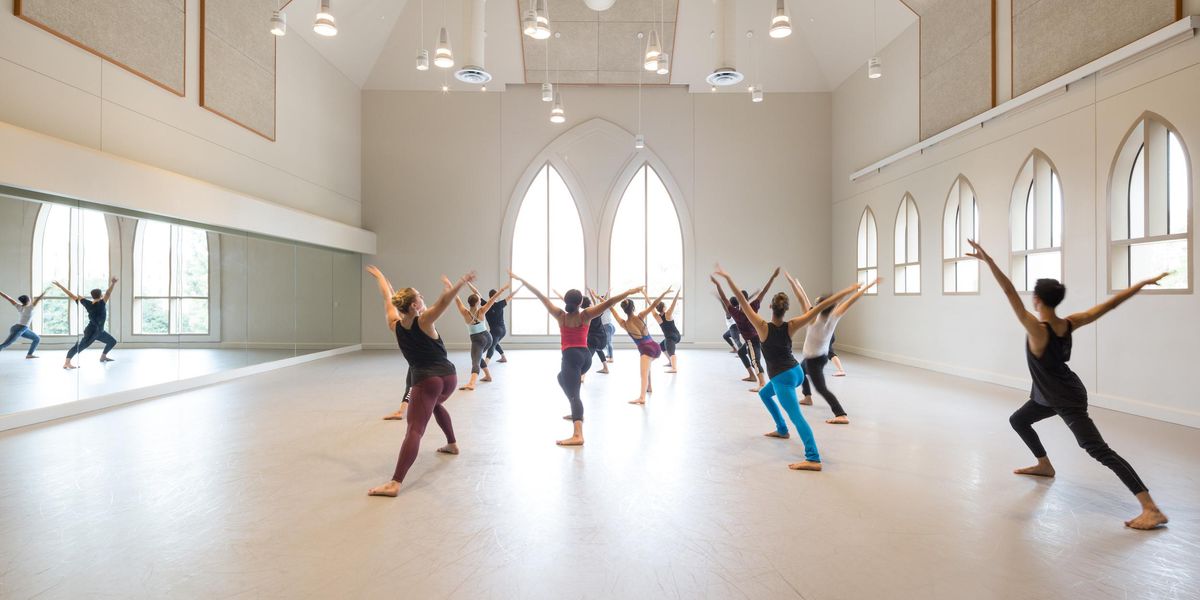Two Ensembles: Godspell on Broadway, and Secus at Juilliard
Dance and theater people have different ways of coalescing into an ensemble. But they have this in common: In order to be a real ensemble, each performer needs to be an individual first, and then a member of a team. To see strong individuals within a strong group is pretty exciting to witness.
Godspell knocked me out as an ensemble when I saw it at Circle in the Square in January. Each one of its actors struck me as bold and very much themselves. Uzo Aduba was earthy and tilted and fierce; her slow-motion tackle of tiny Anna Maria Perez de Tagle was mesmerizing. And de Tagle kept surprising. George Salazar was so all-out goofy that it’s like no one ever taught him moderation—thank goodness.
Wallace Smith had a touch of the Sidney Poitier dignity in his voice and stance. Lindsay Mendez wrinkled her nose with special élan—shades of Gilda Radner. The incredibly versatile Telly Leung had a winning sweetness.
(Left to Right: Telly Leung, Wallace Smith and Lindsay Mendez. Photo: Jeremy Daniel, Courtesy Godspell)
One of the devices that worked gloriously well was that one actor would mouth words while another in another part of the stage would actually be speaking. For the audience, it took a while to realize whose voice you’re hearing, but that makes for a pleasant confusion.
Some of the cast’s talents were revealed gradually. In one scene where Aduba is scorned and stoned, she looked scrappy, haunted. And then she started singing in a gritty and gorgeously gnarled voice.
When the genteel Morgan James, who’s a beautiful mover, opened her mouth to sing, you saw/heard another whole dimension of her character. Hers was a sexy, languid voice for the song “Turn back O man.”
(Nick Blaemire with guitar and company perform “We Beseech Thee.” Photo: Jeremy Daniel, Courtesy Godspell)
They are all stage animals, with stage instincts. But as much as they zoom past moderation in their individual portrayals, they were incredibly tuned in to each other.
A different kind of ensemble performed Ohad Naharin’s Secus at Juilliard a couple weeks ago. Again, I noticed certain individuals before noticing how in-sync they were as a group. There’s the boy with the topknot, Kyle Scheurich, who did everything with crazy energy. Ingrid Kapteyn has a spiky way of moving even before she announces the “Welcome” song at the end. The tall Gentry George moves like a gazelle.
(Juilliard students Kyle Scheurich on right, Meghan Fluker on left in Ohad Naharin’s SECUS, photo by Rosalie O’Connor, Courtesy Juilliard)
But a dance ensemble is more about space and less about characters. The dancers know how close or far to get to another dancer. In Secus, it was sometimes too close for comfort—and not because of romance—but that’s part of the feeling of dancing right up to the edge.
There’s a sort of fractured ballroom duet for two guys that made tears spring to my eyes. I don’t know why, but I think it’s because of the ensemble of two. Garth Johnson had a vulnerability amidst his aggression; he and Scott McCabe danced with such an urgent kind of playfulness—like two very serious children who are not afraid to confront each other.
And in the final section, all 17 dancers gradually feed in to the group action of step, step, step, and curve with elbows bent and palms facing down so it’s like a pounce. The pounce happens at irregular intervals, but still they are all in complete unison, threading through the space. So after this very hard-edged choreography, full of people doing weird things in all directions, they all come together doing one thing—to the Beach Boys’ warm and fuzzy welcome song. It’s such a surprise to end on a sweet, warm, light note. The lights are dimming and we can’t see their faces, but we know, because no one’s crashing into anyone else, that they have keen awareness of their fellow dancers’ paths in space.
(Ingrid Kapteyn in SECUS, Photo by Rosalie O’Connor, Courtesy Juilliard)
It’s remarkable that a group of students would attain this level of ensemble: strong individuals who also are part of the collective rhythm. The piece was staged by Danielle Agami, who often sets Naharin work on other companies. (I’m pretty sure that gaga sessions are part of the preparation.) And in Secus, the students looked very different from the majestic demeanor they adopt for the José Limón piece, or the designed beauty of Nacho Duato’s Gnawa.
(Note: The Batsheva Dance Company has a second company called the Batsheva Ensemble. They are a great ensemble but that’s not the group I’m talking about here.)




